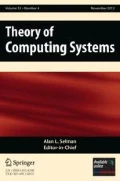Abstract
Assuming thatk≥2 and Δ /P k does not have p-measure 0, it is shown that BP · Δ /P k =Δ /P k . This implies that the following conditions hold if Δ P2 does not have p-measure 0:
-
(i)
AM ∩ co-AM is low for Δ P2 . (Thus BPP and the graph isomorphism problem are low for Δ P2 .)
-
(ii)
If Δ P2 ≠ PH, then NP does not have polynomial-size circuits.
Similar content being viewed by others
References
E. Allender and M. Strauss. Measure on small complexity classes with applications for BPP. InProceedings of the 35th Symposium on Foundations of Computer Science, pages 807–818. IEEE Computer Society Press, New York, 1994.
J. L. Balcázar, J. Díaz, and J. Gabarró.Structural Complexity I. Springer-Verlag, Berlin, 1994.
M. Bellare and S. Goldwasser. The complexity of decision versus search.SIAM Journal on Computing, 23:97–119, 1994.
D. P. Bovet and P. Crescenzi.Introduction to the Theory of Complexity. Prentice Hall, Englewood Cliffs, NJ, 1994.
D. W. Juedes. The Complexity and Distribution of Computationally Useful Problems. Ph.D. thesis, Iowa State University, 1994.
D. W. Juedes and J. H. Lutz. The complexity and distribution of hard problems.SIAM Journal on Computing, 24:279–295, 1995.
D. W. Juedes and J. H. Lutz. Completeness and weak completeness under polynomial-size circuits.Information and Computation, 125:13–31, 1996.
R. Karp and R. Lipton. Some connections between nonuniform and uniform complexity classes. InProceedings of the 12th ACM Symposium on Theory of Computing, pages 302–309. ACM, New York, 1980.
A. Klapper. Generalized lowness and highness and probabilistic classes.Mathematical Systems Theory, 22:37–45, 1989.
K. Ko. Separating and collapsing results on the relativized probabilistic polynomial-time hierarchy.Journal of the Association for Computing Machinery, 37:415–438, 1990.
K. Ko and U. Schöning. On circuit-size complexity and the low hierarchy in NP.SIAM Journal on Computing, 14:41–51, 1985.
J. Köbler. On the structure of low sets. InProceedings of the Tenth Structure in Complexity Theory Conference, pages 246–261. IEEE Computer Society Press, New York, 1995.
J. Köbler, U. Schöning, and J. Torán.The Graph Isomorphism Problem. Birkhäuser, Berlin, 1993.
J. Köbler and O. Watanabe. New collapse consequences of NP having small circuits. InProceedings of the 22nd International Colloquium on Automata, Languages, and Programming, pages 196–207. Springer-Verlag, Berlin, 1995.
C. Lautemann. BPP and the polynomial hierarchy.Information Processing Letters, 14:215–217, 1983.
J. H. Lutz. An upward measure separation theorem.Theoretical Computer Science, 81:127–135, 1991.
J. H. Lutz. Almost everywhere high nonuniform complexity.Journal of Computer and System Sciences, 44:220–258, 1992.
J. H. Lutz. A pesudorandom oracle characterization of BPP.SIAM Journal on Computing, 22:1075–1086, 1993.
J. H. Lutz. The quantitative structure of exponential time. InProceedings of the Eighth Structure in Complexity Theory Conference, pages 158–175. IEEE Computer Society Press, New York, 1993.
J. H. Lutz. Weakly hard problems.SIAM Journal on Computing, 24:1170–1189, 1995.
J. H. Lutz. Resource-bounded measure. In preparation.
J. H. Lutz and E. Mayordomo. Measure, stochasticity, and the density of hard languages.SIAM Journal on Computing, 23:762–779, 1994.
J. H. Lutz and E. Mayordomo. Cook versus Karp-Levin: Separating completeness notions if NP is not small.Theoretical Computer Science, 146:141–163, 1996.
J. H. Lutz and W. J. Schmidt. Circuit size relative to pseudorandom oracles.Theoretical Computer Science, 107:95–120, 1993.
E. Mayordomo. Almost every set in exponential time is P-bi-immune.Theoretical Computer Science, 136(2):487–506, 1994.
E. Mayordomo. Contributions to the Study of Resource-Bounded Measure. Ph.D. thesis, Universitat Politècnica de Catalunya, Barcelona, 1994.
N. Nisan and A. Wigderson. Hardness vs. randomness.Journal of Computer and System Sciences, 49:149–167, 1994.
C. H. Papadimitriou.Computational Complexity. Addison-Wesley, Reading, MA, 1994.
U. Schöning. A low and high hierarchy within NP.Journal of Computer and System Sciences, 27:14–28, 1983.
U. Schöning. Graph isomorphism is in the low hierarchy.Journal of Computer and System Sciences, 37:312–323, 1988.
U. Schöning. Probabilistic complexity classes and lowness.Journal of Computer and System Sciences, 39:84–100, 1989.
M. Sipser. A complexity-theoretic approach to randomness. InProceedings of the 15th ACM Symposium on Theory of Computing, pages 330–335. ACM, New York, 1983.
L. J. Stockmeyer. The polynomial-time hierarchy.Theoretical Computer Science, 3:1–22, 1977.
C. B. Wilson. Relativized circuit complexity.Journal of Computer and System Sciences, 31:169–181. 1985.
C. Wrathall. Complete sets and the polynomial-time hierarchy.Theoretical Computer Science, 3:23–33, 1977.
S. Zachos and H. Heller. A decisive characterization of BPP.Information and Control, 69:125–135, 1986.
Author information
Authors and Affiliations
Additional information
This research was supported in part by National Science Foundation Grant CCR-9157382, with matching funds from Rockwell International, Microware Systems Corporation, and Amoco Foundation.
Rights and permissions
About this article
Cite this article
Lutz, J.H. Observations on measure and lowness for Δ P2 . Theory of Computing Systems 30, 429–442 (1997). https://doi.org/10.1007/BF02679469
Received:
Accepted:
Published:
Issue Date:
DOI: https://doi.org/10.1007/BF02679469




